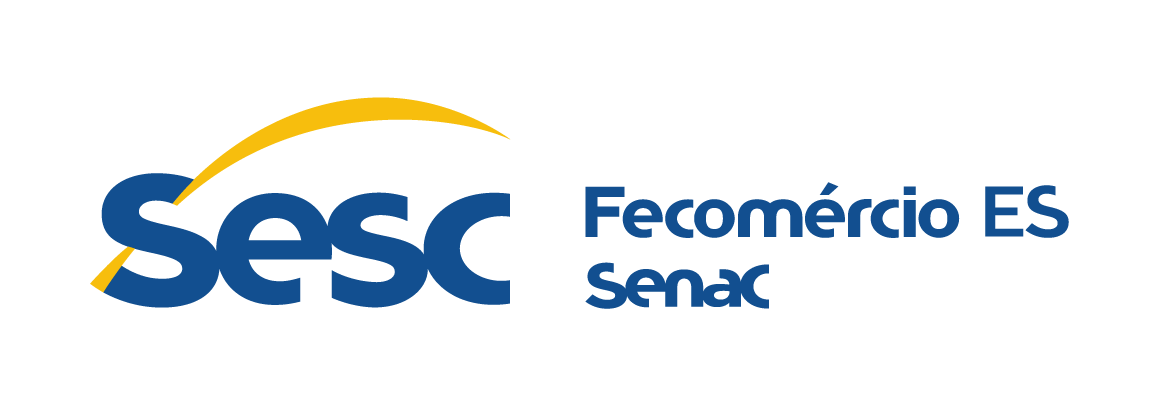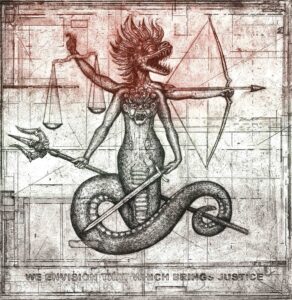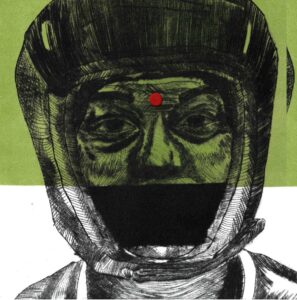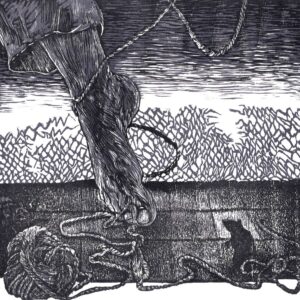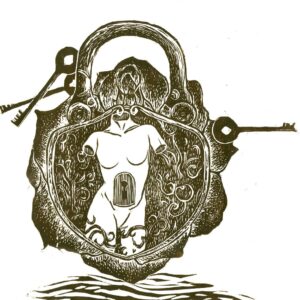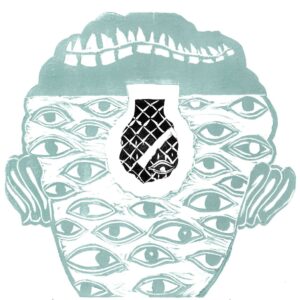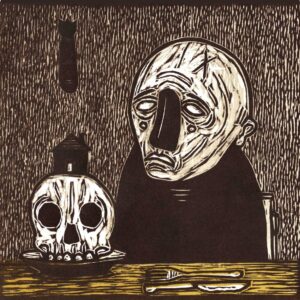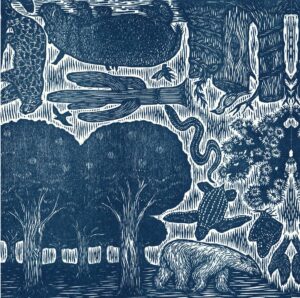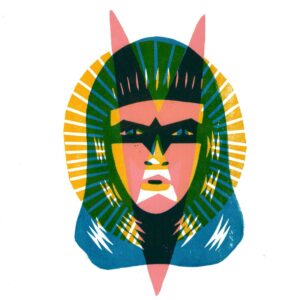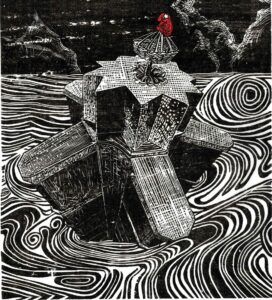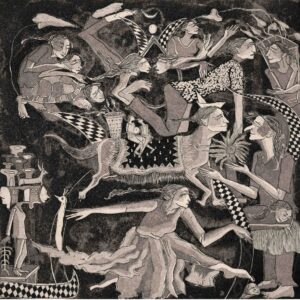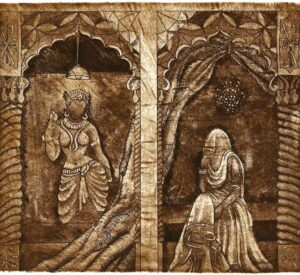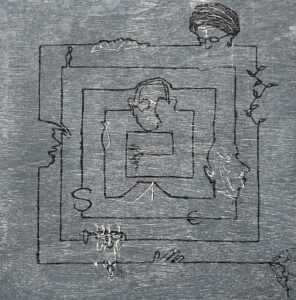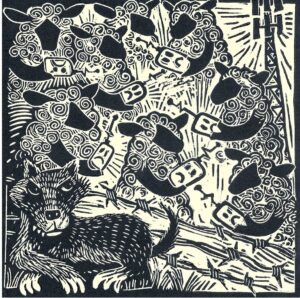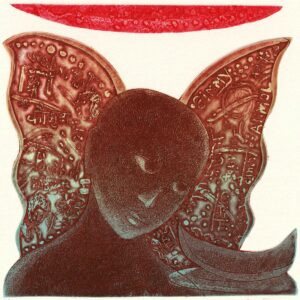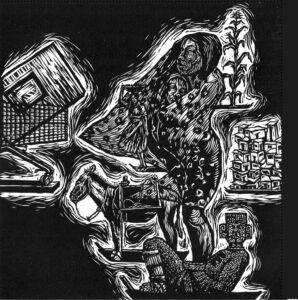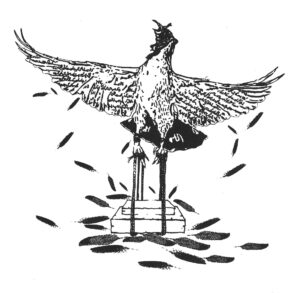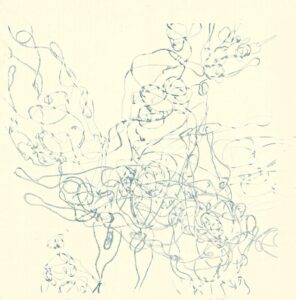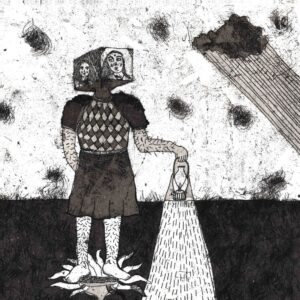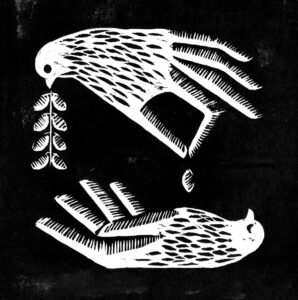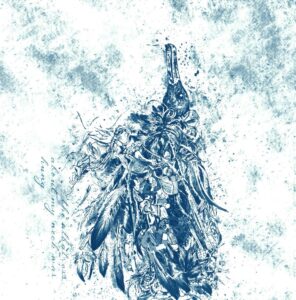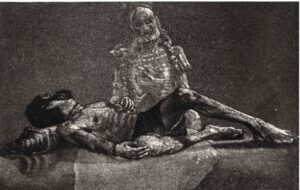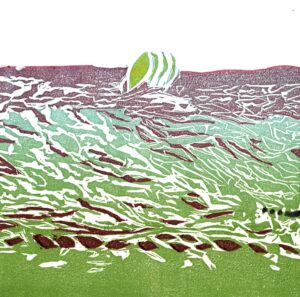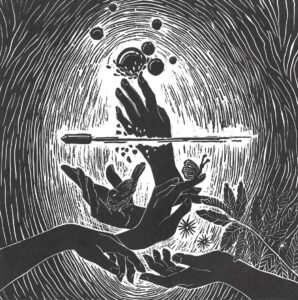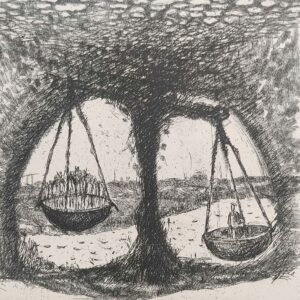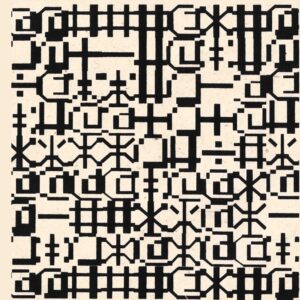Gravuras do Mundo em Crise: Imprimindo Justiça
No Centro Cultural Sesc Glória, a arte é compreendida como uma experiência de encontro e reflexão. A exposição internacional “Gravuras do Mundo em Crise: Imprimindo Justiça”, realizada através do Projeto Arte Sesc, chega ao Espírito Santo como desdobramento do International Print Exchange Programme (IPEP Índia) — iniciativa que, há mais de uma década, conecta artistas de diferentes contextos em torno da gravura como linguagem de diálogo e transformação social. Idealizado na Índia, o projeto já percorreu diversos países e, nesta edição, soma-se a 18 obras de artistas locais, ampliando o alcance dessa rede global.
Realizada pelo Sesc Espírito Santo, a exposição reforça o compromisso institucional com a democratização do acesso à cultura. Ser parceiro de um projeto de tal relevância significa não apenas aproximar continentes, mas também consolidar o Espírito Santo como parte ativa no circuito artístico internacional. Assim, o Centro Cultural Sesc Glória, por meio do Projeto Arte Sesc, reafirma sua missão de ser um espaço vivo de cultura, capaz de gerar experiências estéticas, educativas e críticas, fortalecendo o circuito artístico capixaba e conectando-o ao mundo.
Idalberto Luiz Moro
Presidente do Conselho Regional Fecomércio/ES
English Translation
Prints of a World in Crisis: Printing Justice
At Centro Cultural Sesc Glória, art is understood as an experience of encounter and reflection. The international exhibition “Prints of a World in Crisis: Printing Justice”, presented through the Arte Sesc Project, arrives in Espírito Santo as an extension of the International Print Exchange Programme (IPEP India) — an initiative that, for over a decade, has connected artists from diverse contexts around printmaking as a language of dialogue and social transformation. Conceived in India, the project has traveled through several countries and, in this edition, is joined by 18 works from local artists, expanding the reach of this global network.
Organized by Sesc Espírito Santo, the exhibition reinforces the institution’s commitment to democratizing access to culture. Being a partner in a project of such relevance means not only bringing continents closer together but also establishing Espírito Santo as an active part of the international artistic circuit. Thus, Centro Cultural Sesc Glória, through the Arte Sesc Project, reaffirms its mission to be a living cultural space — one capable of generating aesthetic, educational, and critical experiences, strengthening the Capixaba art scene and connecting it to the world.
Idalberto Luiz Moro
President of the Regional Council, Fecomércio/ES
Ecos da Troca
No IPEP Índia, acreditamos no poder da arte como forma de diálogo — uma ponte que conecta artistas entre culturas, línguas e fronteiras. O que começou como uma iniciativa de uma pequena comunidade de gravadores evoluiu para uma vibrante rede global, com mais de 115 exposições ao redor do mundo e 375 participantes. Trata-se de um ecossistema onde a arte não se limita às paredes; ela viaja, troca de mãos e encontra novos significados — e faz tudo isso sem as amarras das transações financeiras. Este é o espírito de troca que alimenta o IPEP Índia: um programa de artistas para artistas, fundamentado na ideia de que o verdadeiro valor nasce das experiências compartilhadas, e não do intercâmbio monetário.
Para a nossa 11ª edição, queríamos dar uma nova dimensão à nossa missão, o que nos levou ao tema “Imprinting Justice” (Imprimindo Justiça), curado por Saad Ghosn, artista e curador libanês-americano reconhecido por sua sensibilidade às questões sociopolíticas globais. A proposta foi explorar o significado de justiça no mundo contemporâneo. Justiça, nesse contexto, não se limita à lei e à ordem — ela abrange equidade, empatia e a luta contra a marginalização. Saad provoca os participantes a refletirem criticamente sobre o papel do artista como agente social e a utilizarem suas obras como lentes para compreender melhor as complexidades da justiça.
O IPEP Índia 2024 é mais do que uma coleção de gravuras; é um convite para testemunhar a arte como força de transformação. Cada obra é uma narrativa, uma pergunta, um vislumbre do mundo do artista. Representa uma jornada — não apenas em quilômetros percorridos, mas em ideias trocadas e vidas tocadas. Por meio dessa iniciativa, continuamos a reafirmar que a arte não se limita a fronteiras físicas — ela é universal, unificadora e resiliente. Aqui, a arte é a voz dos que não têm voz, um clamor por justiça e uma ponte que nos conecta a todos.
Obrigado por se juntar a nós nesta jornada notável.
Esperamos que você encontre aqui inspiração, conexão e sentido.
Rajesh Pullarwar
Artista e Gravador
Fundador e diretor, IPEP Índia
English Translation
Echoes of Exchange
At IPEP India, we believe in the power of art as a form of dialogue—a bridge connecting artists across cultures, languages, and borders. What began as an initiative driven by a small community of printmakers has evolved into a vibrant, global network, with over 115 exhibitions worldwide and 375 participants. It’s an ecosystem where art doesn’t merely reside on walls; it travels, it exchanges hands, it finds new meanings – and it does so without the bounds of financial transactions. This is the spirit of barter that fuels IPEP India: a program for artists, by artists, grounded in the idea that true value comes from shared experiences, not monetary exchange.
For our 11th edition, we wanted to bring a new layer of depth to our mission, which led us to the theme Imprinting Justice, curated by Saad Ghosn, a Lebanese-American curator with a keen insight into global socio-political issues. The idea was to explore what justice means in today’s world. Justice, in this context, isn’t merely about law and order – it’s about equity, empathy, and the fight against marginalisation. Saad challenges participants to think critically about an artist’s role as a social advocate and to use their work as a lens through which we might better understand the complexities of justice.
IPEP India 2024 is more than just a collection of prints; it’s an invitation to witness art as a force for change. Each piece is a narrative, a question, an insight into the artist’s world. It represents a journey, not just in miles travelled but in ideas exchanged and lives touched. Through this initiative, we continue to prove that art is not confined by physical boundaries – it is universal, unifying, and resilient. Here, art is a voice for the voiceless, a plea for justice, and a bridge that connects us all.
Thank you for joining us on this remarkable journey.
We hope you find inspiration, connection, and meaning here.
Rajesh Pullarwar
Artista e Gravador
Fundador e diretor, IPEP Índia
Imprimindo Justiça
“A arte verdadeira é a voz do artista diante daquilo que é importante para ele e de sua contribuição para um mundo melhor.”
Para esta edição do IPEP 2024, convidamos os artistas a utilizarem suas gravuras como voz — uma expressão de reflexão sobre um tema de justiça social que lhes é caro e que desejam ver ouvido e transformado em ação.
A injustiça social é um campo vasto, pois afeta todos os aspectos da vida humana. No entanto, queremos que o tema se concentre nas questões atuais que nossas sociedades e o mundo enfrentam de maneira ampla — e não em temas estritamente pessoais, filosóficos ou existenciais, que, embora relevantes, possuem outros desdobramentos.
Entre os temas possíveis estão, mas não se limitam a: desigualdade, discriminação, pobreza, violência e guerra, abuso dos direitos humanos (de gênero, de minorias, religiosos, de liberdade etc.), refugiados e deslocados, e questões ambientais.
Permitir que cada artista participante manifeste suas próprias preocupações e perspectivas pessoais sobre a justiça social, a partir de suas experiências, busca empoderá-los — e gerar obras criativas de forte impacto. Essa diversidade de vozes resultará em uma ampla mostra de inquietações enfrentadas por nossas sociedades e por nosso mundo, trazendo também diferentes perspectivas culturais, de acordo com o país de origem de cada artista.
O título “Imprinting Justice” (Imprimindo Justiça) foi escolhido para esta edição do intercâmbio por seu duplo sentido: “Justice”, apontando para o foco das obras apresentadas; e “Imprinting”, que faz alusão não apenas ao meio da gravura como técnica de impressão, mas, mais profundamente, ao papel ativo do artista em deixar sua marca, em agir para instaurar uma mudança em direção à justiça.
Saad Ghosn
Curador, Diretor – SOS Art (EUA)
Curador, IPEP Índia 2024
English Translation
Imprinting Justice
Truthful art is the voice of the artist for what is important to them and for their contributions to a better world. For this IPEP 2024 we would like to invite artists to use their print as their voice to reflect on an issue of social justice that is close to their heart and that they would like to see heard and addressed.
Social injustice is broad as it affects every aspect of our life. We would like the theme, however, to be limited to current issues that our society and world are facing at large, and not to personal philosophical and/or existential themes that may well have their own bearing on social justice. Examples of intended themes include, but are not limited to, inequality, discrimination, poverty, violence and war, abuse of human rights (gender, minorities, religious, freedom, etc.), refugees and displaced, environment.
Allowing each participating artist to add their own particular concern and personal perspective about social justice as they experience it will hopefully empower them, and lead to an impactful creative piece of art. It will also contribute to a display of a large array of concerns as faced by our society and by our world, adding at the same time different cultural perspectives to the theme according to each artist’s country of origin.
“Imprinting Justice” has been selected as the title for this Exchange: “Justice” pointing to the focus of the submitted works; and “Imprinting” alluding not only to the specific tool of printmaking being used, but also, and more importantly, to the active role of the artist in using their print for building and instauring a change toward justice.
Saad Ghosn, USA
Curator, Director – SOS Art
Curator, IPEP India 2024
Fronteiras feridas, gravuras como travessia
Mais do que a exibição de uma coleção de gravuras contemporâneas, esta exposição é um convite ao diálogo — uma oportunidade de abrir janelas para que o espectador se identifique com as angústias e desejos representados, para além das barreiras geográficas e sociopolíticas de um mundo em crise. Cada obra expressa a resposta do artista a uma sensação de injustiça difusa que atravessa a relação consigo, com o outro e com seu próprio território em trânsito.
Com mais de trinta olhares lançados sobre um tema comum, constrói-se um mosaico de denúncias que abordam as múltiplas violações de direitos humanos em seus diversos aspectos. As gravuras, produzidas com diferentes técnicas em nove países, percorrem grandes distâncias e formam um fluxo de correspondências que revela a universalidade das feridas deixadas por esses abusos — mas, sobretudo, a força da arte em impactar, questionar e articular uma comunidade global engajada em promover transformações.
Celebramos o poder de sensibilização de cada uma dessas obras, e especialmente a abertura para um debate capaz de atravessar fronteiras, línguas e culturas, que o conjunto dessas vozes e imagens nos desperta. Que, ao passar por aqui, essas discussões — simultaneamente tão íntimas e coletivas — se amplifiquem em sentidos, e que possamos continuar a reivindicar justiça.
Noemi Masters
Arte educadora
English Translation
Wounded borders, prints as passage
More than the display of a collection of contemporary prints, this exhibition is an invitation to dialogue — an opportunity to open windows through which the viewer may recognize their own anxieties and desires reflected beyond the geographic and sociopolitical boundaries of a world in crisis. Each work expresses the artist’s response to a diffuse sense of injustice that permeates the relationship with oneself, with others, and with one’s own territory in transit.
With more than thirty perspectives cast upon a common theme, a mosaic of denouncements is built, addressing the multiple violations of human rights in their many forms. The prints, produced through diverse techniques across nine countries, travel great distances and form a flow of correspondences that reveals the universality of the wounds left by these abuses — but, above all, the power of art to move, to question, and to connect a global community committed to transformation.
We celebrate the power of each of these works to awaken sensitivity, and especially their openness to a dialogue capable of crossing borders, languages, and cultures — a dialogue sparked by the convergence of these voices and images. As you pass through this space, may these discussions — at once intimate and collective — expand in meaning, and may we continue to claim justice.
Noemi Masters
Art Educator
Confluências
A exposição Gravuras do Mundo em Crise: Imprimindo Justiça promove um diálogo visual e reflexivo sobre temas cruciais da contemporaneidade: as guerras, a fome, os deslocamentos forçados, as ditaduras, a violência, a crise climática… Poderíamos considerar esta mostra um relacionamento cultural mútuo entre dois continentes, nos remetendo à esperança, a resistência e à resiliência por intermédio de ações culturais coletivas em prol da paz e da justiça social, assim reforçando o compromisso da arte como instrumento de transformação. Nesta mostra, são apresentadas 36 gravuras originais produzidas por artistas de nacionalidades diversas, proporcionando ao espectador um rico panorama da gravura contemporânea.
Em sintonia com a exposição internacional, está presente um grupo de artistas locais, visando estabelecer um contraponto entre as duas mostras, assim evidenciando o pujante estágio da gravura capixaba atual. Dezoito gravadores, representados por três gerações distintas, integram a mostra, irmanados pelo amor à gravura, bem como pela resiliência para continuar produzindo.
Gravuras do Mundo em Crise: Imprimindo Justiça e Confluências apresentam um recorte do que está sendo produzido internacionalmente e no Espírito Santo, evidenciando a pujância da gravura enquanto meio expressivo no cenário contemporâneo.
Fernando Gómez Alvarez. Artista Plástico, curador e colecionador.
Professor titular de gravura na Universidade Federal do Espírito Santo – UFES.
Bia Azurza Nogueira, artista plástica e linguista, revisão de textos.
English Translation
Confluences
The exhibition “Engravings of the World in Crisis: Printing Justice” promotes a visual and reflective dialogue on crucial contemporary issues: wars, hunger, forced displacement, dictatorships, violence, the climate crisis… We could consider this exhibition a mutual cultural relationship between two continents, reminding us of hope, resistance, and resilience through collective cultural actions in favor of peace and social justice, thus reinforcing the commitment of art as an instrument of transformation. This exhibition features 36 original prints produced by artists of various nationalities, providing the viewer with a rich overview of contemporary printmaking.
In tune with the international exhibition, a group of local artists is present, aiming to establish a counterpoint between the two shows, thus highlighting the vigorous stage of current Espírito Santo engraving. Eighteen engravers, representing three distinct generations, are part of the exhibition, united by their love of engraving, as well as their resilience to continue producing.
Engravings of the World in Crisis: Printing Justice” and “Confluências” present a snapshot of what is being produced internationally and in Espírito Santo, highlighting the vitality of engraving as an expressive medium in the contemporary scene.
Fernando Gómez Alvarez. Visual artist, curator, and collector.
Full Professor of Printmaking at the Federal University of Espírito Santo – UFES
Bia Azurza Nogueira, visual artist and linguist, text revision.
Gravuras em exposição
IPEP
Gravuras em exposição
Confluências
Da série Paisagens, Raios
Da série Paisagens, Raios
gravura em relevo sobre pedra-sabão, edição de 05 exemplares
23,5 cm x 32 cm
2025
Acervo da artista
Jovani Dala Bernardina
A imagem impressa a partir de matriz em pedra-sabão revela-se como uma inscrição cósmica sobre o papel. Suas linhas, que cintilam no escuro, lembram relâmpagos fossilizados — trajetórias de energias que atravessam o tempo e se fixam na matéria. No contraste entre a densidade do negro e a vibração das fissuras luminosas, o instante efêmero do raio se eterniza, transformando-se em cartografia do invisível. É um sopro de luz gravado na permanência mineral, uma instância da tensão entre permanência e desaparecimento, silêncio e brilho — como se o cosmos tivesse autografado o gesto do artista, ainda que por um instante.
Vitória, ES, 07/06/1973.
Artista visual. Doutoranda CAPES/PPGA/UFES. Mestra em Artes (2025), Bacharel em Artes Plásticas (2022).
English Translation
From the series Landscapes, Lightning Bolts
relief engraving on soapstone, edition of 5 copies
23.5 cm x 32 cm
2025
Artist’s collection
Jovani Dala Bernardina
The image printed from a soapstone matrix reveals itself as a cosmic inscription on paper. Its lines, which shimmer in the dark, resemble fossilized lightning bolts — trajectories of energy that cross time and fix themselves in matter. In the contrast between the density of black and the vibration of luminous fissures, the ephemeral instant of the lightning bolt is eternalized, transforming into a cartography of the invisible. It is a breath of light engraved in mineral permanence, an instance of tension between permanence and disappearance, silence and brightness — as if the cosmos had autographed the artist’s gesture, if only for a moment.
Vitória, ES, July 06, 1973.
Visual artist. PhD candidate CAPES/PPGA/UFES. Master of Arts (2025), Bachelor of Fine Arts (2022).
Arquivado
Arquivado
Monotipia com pigmento obtido de feijão e aquarela impresso sobre papel Canson Aquarela de 300 gramas
20,5 cm x 29 cm
2025
Acervo da artista
Giani Gomes dos Santos Piol
Pesquisa formas de transformar resíduos orgânicos em materiais artísticos desde 2013. A ideia surgiu da constatação da enorme quantidade de alimentos descartados nas feiras livres da cidade. A pesquisa a levou a estudar a extração de pigmentos naturais, tintas e corantes da referida matéria-prima, assim como a testá-los em diversos tipos de suportes. Tem aplicado os resultados da sua pesquisa tanto no campo artístico como no pedagógico. Neste caso, está atrelada à conscientização dos discentes sobre a necessidade de reciclar materiais. Suas obras abordam temas como paisagem, memória, cultura e arte abstrata.
Vitória, ES, 19/03/1979. Artista visual formada pela UFES, educadora, pesquisadora, palestrante e gravurista. Graduada no curso de Arquitetura e Urbanismo pela Faculdade de Franca (SP). Atuou como monitora voluntária na Galeria Homero Massena e LABGRAV/UFES. Estagiária e mediadora do SESC Glória. Professora de Arte PMS/ES (2018 a 2022).
English Translation
Archived
Monotype with pigment obtained from beans and watercolor printed on 300-gram Canson Aquarela paper
20.5 cm x 29 cm
2025
Artist’s collection
Giani Gomes dos Santos Piol
She has been researching ways to transform organic waste into artistic materials since 2013. The idea arose from the realization of the enormous amount of food discarded at the city’s open markets. This research led her to study the extraction of natural pigments, paints, and dyes from this raw material, as well as testing them on various supports. She has applied the results of her research in both artistic and educational fields. In the latter case, it is linked to raising students’ awareness of the need to recycle materials. Her works address themes such as landscape, memory, culture, and abstract art.
Vitória, ES, March 03, 1979.
Visual artist graduated from UFES, educator, researcher, lecturer, and printmaker. Graduated in Architecture and Urbanism from Faculdade de Franca (SP). She has worked as a volunteer monitor at Galeria Homero Massena and LABGRAV/UFES, intern and mediator at SESC Glória, and art teacher at PMS/ES (2018–2022).
Da Série diálogos com a minha mãe IV
Da Série diálogos com a minha mãe IV
xilogravura e gravura em relevo sobre papel Lana Gravure de 300 gramas, impressão única
25 cm
2024
Acervo da artista
Virginia Collistet
A pesquisa se desenvolve a partir da experimentação gráfica, explorando diversas técnicas — como xilogravura, linoleogravura, carimbos e gravura em metal —, ampliando meu repertório e possibilitando trabalhar com essas técnicas, apresentando gravuras em uma obra única. Sobrepor matrizes, dialogar com formas que vão além da representação visual direta e investigar o que não é imediatamente perceptível, estabelecendo relações subjetivas que a própria forma me sugere, constitui um desafio diário e motivo norteador da minha pesquisa artística. Para desenvolver este trabalho, utilizei como matriz um detalhe do crochê de minha mãe registrado com uma massa de modelar que, depois de seca, transformou-se em matriz para impressão.
Resende, RJ, 28/11/1960.
Artista plástica e educadora cuja produção consiste em gravura contemporânea e linguagem abstrata.
English Translation
From the series Dialogues with my mother IV
Woodcut and relief engraving on 300-gram Lana Gravure paper, single print
25 cm
2024
Artist’s collection
Virginia Collistet
My research develops through graphic experimentation, exploring various techniques — such as woodcut, linocut, stamping, and etching — expanding my repertoire and allowing me to work with these processes, presenting prints as a single unified work. Layering matrices, engaging with forms that go beyond direct visual representation, and investigating what is not immediately perceptible — establishing subjective relationships suggested by the form itself — constitute a daily challenge and a guiding force in my artistic research. To create this work, I used as a matrix a detail of my mother’s crochet, imprinted with modeling clay that, once dry, was turned into a printing plate.
Resende, Rio de Janeiro, November 28, 1960.
A visual artist and educator whose work focuses on contemporary printmaking and abstract language.
Gnosis
Gnosis
Bloco de MDF pirografado
50 cm x 40 cm
2025
Acervo do artista
Gêison Siilva
A convergência entre tradição cultural e contemporaneidade é o substrato que potencializa a união do imaginário individual do artista com o imaginário coletivo. O papel da criatividade, enquanto processo de transformação da matéria e da própria espiritualidade, revela ao espectador um olhar atento às raízes populares da sociedade.
Cabo de Santo Agostinho, PE, 03/10/1991. Artista plástico autodidata pernambucano residente no Espírito Santo. Seu trabalho transita entre diferentes linguagens — pintura a óleo, guache, cerâmica fria, escultura e pirografia — tencionando unir técnica, experimentação e sensibilidade poético-espiritual. Atua de forma ativa na atual cena cultural capixaba, promovendo exposições, oficinas e feiras de artesanato.
English Translation
Gnosis
Pyrographed MDF block
50 cm x 40 cm
2025
Artist’s collection
Gêison Siilva
The convergence between cultural tradition and contemporaneity is the foundation that enhances the union of the artist’s individual imagination with the collective imagination. The role of creativity, as a process of transforming matter and spirituality itself, reveals to the viewer a gaze attentive to the popular roots of society.
Cabo de Santo Agostinho, PE, March 03, 1991.
Self-taught plastic artist from Pernambuco residing in Espírito Santo. His work spans different media — oil painting, gouache, cold ceramics, sculpture, and pyrography — aiming to unite technique, experimentation, and poetic-spiritual sensitivity. He is actively engaged in Espírito Santo’s current cultural scene, promoting exhibitions, workshops, and craft fairs.
Gosto de te ver ao sol, Leãozinho
Ref.:
Gosto de te ver ao sol, Leãozinho
Impressão fotografica de serigrafia sobre papel A3 200 gramas
27,9 cm x 32 cm
2025
Acervo do artista
Eric Scarpel
Na impressão, manipulo a densidade das tintas, tornando a tinta cinza menos densa que a branca e, ao passar o rodo, elas não se misturam, gerando a monotipia.
São José dos Campos, SP, 05/08/2003. Graduando da UFES, é um artista visual cuja prática engloba gravura, desenho, pintura e fotografia, explorando questões associadas à biologia, à natureza e à sociedade.
English Translation
I like to see you in the sun, Little Lion
Photographic silkscreen print on 200 gram A3 paper
10.9 inches x 12.6 inches
2025
Artist’s collection
Eric Scarpel
In the printing process, I manipulate the density of the inks, making the gray ink less dense than the white one, and as I pull the screen-printing squeegee, they do not mix, creating the monotype.
São José dos Campos, SP, Agust 08, 2003.
Undergraduate student at UFES, he is a visual artist whose practice encompasses printmaking, drawing, painting, and photography, exploring issues related to biology, nature, and society.
Injustiça
Injustiça
Gravura digital – Desenho a lápis sobre papel de 200 gramas, com posterior intervenção digital (Photoshop), impresso em gráfica sobre papel Couchê com 300 dpi
42 cm x 29,7 cm
2025
Acervo do artista
Samuel Eufraso
Desenvolve projetos que combinam técnicas tradicionais, digitalização e intervenção digital — mediadas pelo domínio de ferramentas como Illustrator, Photoshop, After Effects e Filmora — em busca de uma narrativa visual criativa. Costuma realizar retratos detalhados, explorando a expressão humana e os contrastes entre o realismo do lápis e elementos digitais abstratos, que visam transmitir emoções ao espectador.
Rio de Janeiro, 29/10/1984.
Designer gráfico e artista plástico, atua desde 2017 na criação de ilustrações, desenhos, pinturas e artes digitais. Idealizador do Coletivo Arte Livre, mora alternadamente nas cidades do Rio de Janeiro e de Vitória.
English Translation
Injustice
Digital engraving – Pencil drawing on 200-gram paper, with subsequent digital intervention (Photoshop), printed on coated paper at 300 dpi
42 cm x 29.7 cm
2025
Artist’s collection
Samuel Eufraso
He develops projects that combine traditional techniques, digitization, and digital intervention — mediated by mastery of tools such as Illustrator, Photoshop, After Effects, and Filmora — in search of a creative visual narrative. He often creates detailed portraits that explore human expression and the contrasts between pencil realism and abstract digital elements, aiming to evoke emotion in the viewer.
Rio de Janeiro, October 29, 1984.
A graphic designer and visual artist, he has worked since 2017 creating illustrations, drawings, paintings, and digital artworks. Founder of Coletivo Arte Livre, he divides his time between Rio de Janeiro and Vitória.
Ninho
Ninho
Gravura em linóleo sobre papel Canson Montval de 300 gramas, edição 1/10
55 cm x 52,5 cm
2025
Acervo do artista
Luciano Belcavello
O trabalho artístico investiga o processo criativo utilizando a técnica da gravura em relevo, desenvolvendo uma poética centrada no cuidado. A imagem do coração protegido pelo ninho faz referência à necessidade de segurança emocional e ao valor dos vínculos afetivos. O suporte utilizado é uma placa vinílica anteriormente aplicada como piso em um prédio da universidade. Essa escolha representa não apenas uma decisão técnica, mas também um posicionamento sobre reutilização e ressignificação de materiais descartados. O processo adota práticas experimentais e incorpora alternativas de impressão de baixa toxicidade, com o objetivo de proporcionar um ambiente seguro ao artista e promover ações ecologicamente responsáveis.
Nova Venécia, ES, 07/02/1983. Graduando de Bacharelado em Artes Plásticas, monitor voluntário da disciplina Gravura. É um artista visual cuja prática engloba gravura, desenho, pintura e fotografia, refletindo sobre os impactos antrópicos nos frágeis ecossistemas do planeta.
English Translation
Nest
Linoleum engraving on 300-gram Canson Montval paper, edition 1/10
55 cm x 52.5 cm
2025
Artist’s collection
Luciano Belcavello
The artistic work investigates the creative process using relief printmaking techniques, developing a poetics centered on care. The image of the heart protected by a nest refers to the need for emotional security and the value of affective bonds. The support used is a vinyl tile previously applied as flooring in a university building. This choice represents not only a technical decision but also a stance on reusing and re-signifying discarded materials. The process adopts experimental practices and incorporates low-toxicity printing alternatives, aiming to provide a safe environment for the artist and promote ecologically responsible actions.
Nova Venécia, ES, July, 02, 1983.Bachelor of Fine Arts student, volunteer monitor of the Printmaking discipline. He is a visual artist whose practice encompasses printmaking, drawing, painting, and photography, reflecting on anthropic impacts on the planet’s fragile ecosystems.
Pensador
Pensador
Gravura em relevo com polpa de papel, pigmento para tecido e colagem de xilogravura, impressão única
38 cm x 28,5 cm
2024
Acervo do artista
Fernando Gómez Alvarez
O eixo da minha atual produção gráfica radica na pesquisa de técnicas de impressão antigas ou consideradas obsoletas, misturando-as em uma espécie de arqueologia da gravura. O trabalho resultante transita entre impressão e objeto em relevo. Paralelamente, investigo materiais e suportes não tradicionais, assim como técnicas de calcogravura que não agridam o meio ambiente.
Havana, Cuba, 31/12/1957. Mora no Brasil desde 1995 e em Vitória, ES, desde 2004. Doutor em Multimeios pela UNICAMP, Mestre em Artes pela UNICAMP. Artista visual multimídia cuja prática engloba gravura de baixa toxidez, desenho, pintura e fotografia, explorando questões associadas à natureza psicológica do indivíduo e suas interações com a sociedade e a política.
English Translation
Thinker
Relief engraving with paper pulp, fabric pigment, and woodcut collage, single print
38 cm x 28.5 cm
2024
Artist’s collection
Fernando Gómez Alvarez
The core of my current graphic production lies in researching ancient or considered obsolete printing techniques, mixing them in a sort of printmaking archaeology. The resulting work moves between print and relief object. Simultaneously, I investigate non-traditional materials and supports, as well as engraving techniques that do not harm the environment.
Havana, Cuba, Decembre 31, 1957.
Has lived in Brazil since 1995 and in Vitória, ES, since 2004. PhD in Multimedia from UNICAMP, Master of Arts from UNICAMP. Multimedia visual artist whose practice includes low-toxicity printmaking, drawing, painting, and photography, exploring issues related to the psychological nature of the individual and their interactions with society and politics.
Por onde piso
Por onde piso
Gravura, colagem e pintura (acrílica, papel, madeira e vidro), impressão única
97 cm x 67 cm
2024
Acervo do artista
Patrick Trugilho
As gravuras que compõem esta obra foram criadas a partir de pisos de linóleo descartados, coletados durante a reforma de um antigo prédio da Universidade Federal do Espírito Santo. Cada matriz de linóleo carrega marcas pré-existentes — cicatrizes deixadas pelo uso cotidiano. Essas marcas se tornam registros físicos de memórias, traduzidas em texturas e padrões que evocam a passagem do tempo e o fluxo constante das vivências humanas. Ao ser verticalizado em um quadro, ele deixa de ser apenas um suporte funcional para se tornar objeto de reflexão e contemplação. Essa inversão de perspectiva nos convida a observar o espaço que sustenta nossos passos, mas que raramente recebe nossa atenção, revelando o impacto humano e as histórias registradas em suas superfícies.
Cachoeiro de Itapemirim, ES, 1992. É artista multidisciplinar formado em Artes Plásticas pela UFES. Sua produção investiga fronteiras, fluxo, equilíbrio e caos, transformando resíduos e experiências cotidianas em narrativas visuais que conectam corpo, memória e espaço.
English Translation
Where I tread
Engraving, collage, and painting (acrylic, paper, wood, and glass), single print
97 cm x 67 cm
2024
Artist’s collection
Patrick Trugilho
The prints that compose this work were created from discarded linoleum floors collected during the renovation of an old building at the Federal University of Espírito Santo. Each linoleum matrix carries pre-existing marks — scars left by daily use. These marks become physical records of memories, translated into textures and patterns that evoke the passage of time and the constant flow of human experiences. When verticalized in a frame, it ceases to be merely a functional support and becomes an object of reflection and contemplation. This inversion of perspective invites us to observe the space that sustains our steps but rarely receives our attention, revealing human impact and the stories recorded on its surfaces.
Cachoeiro de Itapemirim, ES, 1992.
Multidisciplinary artist graduated in Fine Arts from UFES. His production investigates borders, flow, balance, and chaos, transforming waste and daily experiences into visual narratives that connect body, memory, and space.
Rosa-Choque
Rosa-choque
Colagem digital sobre papel Couchê de 200 gramas
27,9 cm x 32 cm
2025
Acervo do artista
Rodolfo Talles Pinheiro Birchler
Trabalha com artes visuais, artes cênicas, multimídia, arte-educação e produção cultural. Há oito anos, sua atuação principal se dá através da Casa Rabisco Estúdio de Arte e Projetos Culturais e, mais recentemente, pelo Coletivo Arte Livre. O rosa-choque presente na obra é uma cor intensa — tão intensa quanto a agressão feita pelos fardados armados. Será que estão prontos para essa comparação?
Dom Eliseu, PA, 20/04/1990.
Egresso da UFES, é um artista visual cuja prática inclui gravura, desenho, arte pública, pintura, performance e fotografia. Seus projetos têm sido aprovados em mais de dez editais públicos, além de diversas iniciativas privadas.
English Translation
Hot pink
Digital collage on 200-gram coated paper
27.9 cm x 32 cm
2025
Artist’s collection
Rodolfo Talles Pinheiro Birchler
He works with visual arts, performing arts, multimedia, art education, and cultural production. For eight years, his main practice has taken place through Casa Rabisco – Art Studio and Cultural Projects, and more recently, through the Coletivo Arte Livre. The hot pink featured in his work is an intense color — as intense as the violence inflicted by the armed uniformed figures. Are they ready for such a comparison?
Dom Eliseu, Pará, April 20, 1990.
A UFES graduate, he is a visual artist whose practice includes printmaking, drawing, public art, painting, performance, and photography. His projects have been selected in over ten public funding calls as well as several private initiatives.
Rugosidade
Rugosidades
Gravura em relevo (Paviflex reaproveitado), técnica da matriz perdida e Suminagashi
27,7 cm x 40 cm
2025
Acervo da artista
Yasmine Chicralla Alvarez
A artista tem como fonte de pesquisa os múltiplos significados da paisagem, principalmente a relação subjetiva do indivíduo com o que está ao seu redor. Em seu percurso cotidiano, registra o que é importante para ela: estruturas em ruínas, pessoas que possuem marcas e histórias, natureza. Coisas que guardam conhecimento e resistem ao tempo, como o conceito de Rugosidades do geógrafo Milton Santos, que dá nome ao trabalho. A partir dos registros fotográficos, recria suas memórias para a gravura como forma de expressão da sua subjetividade e gesto e como busca de pertencimento à cidade.
Mariana, MG, 11/01/1990.
Formada em Geografia (2018) e graduanda em Artes Plásticas desde 2020. Atua na relação entre essas duas formas de conhecimento por meio da fotografia, do desenho e da gravura, discutindo a paisagem urbana.
English Translation
Roughnesses
Relief engraving (recycled Paviflex), lost matrix technique, and Suminagashi
27.7 cm x 40 cm
2025
Artist’s collection
Yasmine Chicralla Alvarez
The artist’s research draws on the multiple meanings of landscape, especially the subjective relationship between the individual and their surroundings. In her daily walks, she records what matters to her: structures in ruins, people marked by stories, and nature. Things that hold knowledge and resist time, echoing the concept of Rugosities by geographer Milton Santos, which gives title to the work. From her photographic records, she recreates her memories through printmaking as an act of expressing her subjectivity and gesture, and as a search for belonging within the city.
Mariana, Minas Gerais, January 11, 1990.
Holds a degree in Geography (2018) and has been studying Fine Arts since 2020. Her work bridges these two fields of knowledge through photography, drawing, and printmaking, reflecting on the urban landscape.
Sem título
Ref.:
Sem título
Cerâmica, madeira e minério de ferro
101,5 cm x 53,7 x 5 cm
2024
Acervo do artista
André Magnago Alves
Tomando como ponto de partida as xilogravuras de matriz cilíndrica feitas durante o bacharelado em Artes, passei a pesquisar matrizes cilíndricas e cônicas em outros materiais, à maneira dos espelhos cilíndricos que geravam figuras anamórficas, muito em voga nos séculos XVIII e XIX. A pesquisa ampliou-se para outros suportes além do papel, como a argila e a argila polimérica.
Cidade Alta, Vitória, ES, 26/06/1985. Artista visual, pesquisador e professor. Mestre em Artes pela UFES. Licenciado em Artes Visuais pela UNIASSELVI e Bacharel em Artes pela UFES.
English Translation
Untitled
Ceramic, wood, and iron ore
101.5 cm x 53.7 x 5 cm
2024
Artist’s collection
André Magnago Alves
Taking as a starting point the cylindrical matrix woodcuts made during my Bachelor’s degree in Arts, I began researching cylindrical and conical matrices in other materials, inspired by cylindrical mirrors that produced anamorphic figures popular in the 18th and 19th centuries. The research expanded to other supports beyond paper, such as clay and polymer clay.
Cidade Alta, Vitória, ES, June 6, 1985.
Visual artist, researcher, and professor. Master of Arts from UFES. Licensed in Visual Arts from UNIASSELVI and Bachelor of Arts from UFES.
Sem título
Sem título
Serigrafia
32,5 cm x 42,2 cm
2025
Acervo da artista
Gabriela Schmidel
A pesquisa poética da artista tem como tema a sua autorrepresentação relacionada à imagem da baleia. Uma relação desenvolvida a partir de experiências de bullying sofridas no início de sua vida, especialmente ao ser chamada de baleia. A poética objetiva se aproxima desses seres sencientes e subverte o significado do termo outrora ligado a ela.
Linhares, ES, 09/05/2000.
Graduanda da UFES, é um artista visual cuja prática engloba gravura, desenho, pintura e fotografia, explorando questões associadas à biologia, à natureza e à sociedade.
English Translation
Untitled
Silkscreen print
32.5 cm x 42.2 cm
2025
Artist’s collection
Gabriela Schmidel
The artist’s poetic research centers on self-representation in relation to the image of the whale. This connection stems from early-life experiences with bullying, particularly being called a whale. Her poetic approach seeks to draw closer to these sentient beings, subverting the meaning once attached to her.
Linhares, Espírito Santo, May 9, 2000.
An undergraduate student at UFES, she is a visual artist whose practice encompasses printmaking, drawing, painting, and photography, exploring themes linked to biology, nature, and society.
Sem título
Sem título
Matriz de Xilogravura em MDF
300 cm x 100 cm
2023
Acervo da artista
Mariana Reis
Sua produção tem como destaque a xilogravura em grandes dimensões, tridimensionalidade e produções audiovisuais dentro do campo da arte pública e bioarte. Entre as temáticas trabalhadas pela artista, sua pesquisa atualmente foca na criação imagética de faunas fantásticas anatomicamente possíveis, resultado do diálogo entre ciência e o fazer artístico.
Brasília, DF, 13/01/1984. Artista visual radicada no Espírito Santo, é graduada e mestre em artes pela UFES e atua também como médica veterinária, trajetória que atravessa e alimenta sua poética visual. Foi professora substituta no Centro de Artes da Universidade Federal do Espírito Santo (UFES) entre os anos de 2017 e 2019 e 2023 e 2025, onde compartilhou seus conhecimentos no campo das artes visuais.
English Translation
Untitled
Woodcut matrix on MDF
300 cm x 100 cm
2023
Artist’s collection
Mariana Reis
Her production highlights large-scale woodcut prints, three-dimensionality, and audiovisual productions within the field of public art and bioart. Among the themes addressed by the artist, her current research focuses on the imagistic creation of anatomically plausible fantastic faunas, resulting from the dialogue between science and artistic making.
Brasília, DF, January, 1, 1984.
Visual artist based in Espírito Santo, graduated and master in arts from UFES, and also works as a veterinary doctor, a trajectory that crosses and nourishes her visual poetics. She was a substitute professor at the Arts Center of the Federal University of Espírito Santo (UFES) between 2017 and 2019 and 2023 and 2025, where she shared her knowledge in the field of visual arts.
Três reis magos
Três reis magos
Xilogravura em compensado naval, impressa em papel arroz. impressão única
69 cm x 121 cm
2023
Acervo da artista
Richard Fiorio
Movida pela Arte Clássica, sua produção busca reinterpretar elementos formais e visuais da Antiguidade, trazendo-os para a contemporaneidade. Inspirada na iconografia medieval, a gravura retrata os Três Reis Magos na passagem bíblica de Mateus 2:1-12. Em um momento de descanso, os personagens — da esquerda para a direita, Gaspar, Baltazar e Melchior — teriam recebido, em sonho, a mensagem de não revelar ao rei Herodes o local de nascimento de Jesus. Na tradição iconográfica, os magos são representados dormindo em uma mesma cama, enquanto o anjo que paira sobre eles aponta para a Estrela de Belém. As características físicas e os elementos decorativos presentes na gravura seguem e expandem os paradigmas cristãos que se estabeleceram durante o primeiro milênio d.C.
Richard Fiorio é artista graduada em Artes Plásticas pela Universidade Federal do Espírito Santo (2023). Explora o desejo de conexão com a história humana e seu processo de criação artística. No plano bidimensional, trabalha com desenho, gravura e pintura; no tridimensional, com a cerâmica.
English Translation
Three Wise Men
Woodcut on marine plywood, printed on rice paper. Single print.
69 cm x 121 cm
2023
Artist’s collection
Richard Fiorio
Moved by Classical Art, her work seeks to reinterpret the formal and visual elements of Antiquity, bringing them into contemporary dialogue. Inspired by medieval iconography, the engraving portrays the Three Wise Men from the biblical passage Matthew 2:1–12. In a moment of rest, the figures — from left to right, Gaspar, Balthazar, and Melchior — are said to have received in a dream the message not to reveal to King Herod the birthplace of Jesus. In iconographic tradition, the Magi are depicted sleeping in the same bed, while the angel hovering above them points to the Star of Bethlehem. The physical traits and decorative elements in the print follow and expand the Christian paradigms established during the first millennium CE.
Richard Fiorio holds a degree in Fine Arts from the Federal University of Espírito Santo (2023). She explores a longing for connection with human history and the artistic creation process. In two-dimensional form, she works with drawing, printmaking, and painting; in three-dimensional form, with ceramics.
Transitórios
Transitórios
monotipia, pigmento sobre matriz de acetato
31,4 cm x 24,4 cm
2023
Acervo do artista
Jocimar Nalesso
Esta monotipia integra uma série de gravuras criadas para serem armazenadas em uma cadeira com gaveta no assento. Os desenhos ficam guardados, mas podem ser observados e apreciados quando a gaveta é aberta. Esta gravura explora a relação entre lugar, ocupação, utilitário e memória — um diálogo sobre espaço, tempo e percepção. Neste desenho, penso no objeto de forma que ele não possa ser ocupado, mas visto, contemplado por sua existência. As cadeiras podem ser vistas como representações da passagem do tempo e suas transformações. Neste e em outros trabalhos, busco refletir sobre como percebemos a existência das coisas e como nos relacionamos com elas. Trata-se de um convite para desafiar nossa percepção e refletir sobre suas inúmeras camadas.
Marechal Floriano, ES, 1971.
Bacharel em Artes pela UFES. Vive e trabalha em Marechal Floriano.
English Translation
Transitory
monotype, pigment on acetate matrix
31.4 cm x 24.4 cm
2023
Artist’s collection
Jocimar Nalesso
This monotype is part of a series of prints created to be stored in a chair with a drawer in the seat. The drawings are kept inside but can be viewed and appreciated when the drawer is opened. This print explores the relationship between place, occupation, utility, and memory — a dialogue about space, time, and perception. In this drawing, I think of the object in a way that it cannot be occupied but seen, contemplated for its existence. Chairs can be seen as representations of the passage of time and its transformations. In this and other works, I seek to reflect on how we perceive the existence of things and how we relate to them. This is an invitation to challenge our perception and reflect on its many layers.
Marechal Floriano, ES, 1971.
Bachelor of Arts from UFES. Lives and works in Marechal Floriano.
Por dentro da mente
Por dentro da mente
ponta-seca em oco-relevo (poliestireno)
32 cm x 24 cm
2023
Acervo da artista
Juliane Mangifesti
Seus trabalhos são auto-representacionais e abordam estados de ânimo e introspecção. A face, quando oculta, reforça a atmosfera de mistério e recolhimento. Da cabeça da personagem emergem formas que simbolizam pensamentos intrusivos e indesejados, representações visuais de conflitos internos que habitam o imaginário e a subjetividade da artista. Nesse sentido, a gravura não apenas materializa aspectos da melancolia vivenciada cotidianamente pela artista, mas também convida o público a refletir sobre a potência da arte como meio de expressão sensível e de compartilhamento de experiências humanas complexas.
Vitória, ES, 13/05/2000. Egressa da UFES em 2024. É uma artista visual cuja prática engloba gravura, desenho, pintura e fotografia, explorando questões associadas à biologia, à psique humana, à natureza e à sociedade.
English Translation
Inside the mind
drypoint in relief (polystyrene)
32 cm x 24 cm
2023
Artist’s collection
Juliane Mangifesti
Her works are self-representational and address moods and introspection. The face, when hidden, reinforces an atmosphere of mystery and withdrawal. From the character’s head emerge forms that symbolize intrusive and unwanted thoughts, visual representations of internal conflicts that inhabit the artist’s imagination and subjectivity. In this sense, the print not only materializes aspects of the melancholy experienced daily by the artist but also invites the public to reflect on the power of art as a means of sensitive expression and sharing complex human experiences.
Vitória, ES, Mach, 05, 2000.
UFES alumna, class of 2024. She is a visual artist whose practice includes printmaking, drawing, painting, and photography, exploring issues related to biology, the human psyche, nature, and society.
O Violinista
O violinista
Ponta-seca sobre Tetra Pak, cópia única sobre papel Filtro de 250 gramas
29,7 cm x 42 cm
2025
Acervo do artista
Alex Barcellos Alves
Gosto muito de tocar violino, por isso realizei este trabalho após assistir a um concerto que me inspirou.
Alex Barcellos Alves
Vitória, ES, 25/05/2007. Mora em Vitória. Frequenta o Projeto de Extensão Ateliê Livre de Gravura, no DAV/CAR/UFES.
English Translation
The Violinist
Drypoint on Tetra Pak, single copy on 250-gram filter paper
29.7 cm x 42 cm
2025
Alex Barcellos Alves
I really enjoy playing the violin, which is why I created this work after attending a concert that inspired me.
Vitória, ES, May 05, 2007.
Lives in Vitória. Participates in the Free Printmaking Studio Extension Project at DAV/CAR/UFES.
Um pouco mais sobre a IPEPI/2024 – Escritores convidados
“Para a nossa 11ª edição, queríamos dar uma nova dimensão à nossa missão, o que nos levou ao tema “Imprinting Justice” (Imprimindo Justiça), curado por Saad Ghosn, artista e curador libanês-americano reconhecido por sua sensibilidade às questões sociopolíticas globais. A proposta foi explorar o significado de justiça no mundo contemporâneo. Justiça, nesse contexto, não se limita à lei e à ordem — ela abrange equidade, empatia e a luta contra a marginalização. Saad provoca os participantes a refletirem criticamente sobre o papel do artista como agente social e a utilizarem suas obras como lentes para compreender melhor as complexidades da justiça.
Para enriquecer essa exploração, temos o prazer de contar com as vozes de dois escritores ilustres, Amrit Kartar, da Índia, e Michel Cassir, da França/Líbano. Seus textos oferecem novas perspectivas sobre as obras desta edição, incentivando os espectadores a ir além do visual e mergulhar nos significados complexos de cada peça. As contribuições de Amrit e Michel elevam este portfólio a uma exploração profunda da capacidade da arte de desafiar, inspirar e provocar”.
English Translation
“For our 11th edition, we wanted to bring a new layer of depth to our mission, which led us to the theme Imprinting Justice, curated by Saad Ghosn, a Lebanese-American curator with a keen insight into global socio-political issues. The idea was to explore what justice means in today’s world. Justice, in this context, isn’t merely about law and order – it’s about equity, empathy, and the fight against marginalisation. Saad challenges participants to think critically about an artist’s role as a social advocate and to use their work as a lens through which we might better understand the complexities of justice.
To enrich this exploration, we’re thrilled to have the voices of two distinguished writers, Amrit Kartar from India and Michel Cassir from France/Lebanon. Their writings offer fresh perspectives on the works in this edition, encouraging viewers to engage beyond the visual and delve into the layered meanings of each piece. Amrit and Michel’s contributions elevate this portfolio into a profound exploration of art’s capacity to challenge, inspire, and provoke though”.
Escreva dois
Amrit Kartar, Índia
Artista, Escritor
Escritor, IPEP Índia 2024
Escreva dois
Amrit Kartar, Índia
Artista, Escritor
Escritor, IPEP Índia 2024
Desde os primórdios da civilização humana, as sociedades têm se debatido com noções de justiça e equidade. Os primeiros sistemas de governança introduziram formas rudimentares de lei e ordem para proteger indivíduos dentro de tribos e comunidades, lançando as bases para o que hoje entendemos por justiça. Esses primeiros códigos legais, como o Código de Hamurabi na antiga Mesopotâmia, estiveram entre as primeiras tentativas de formalizar normas sociais. Eles representaram um passo em direção ao uso da lei como estrutura para preservar a ordem social. No entanto, com o desenrolar da história, tornou-se evidente que a lei poderia servir tanto como um escudo para a humanidade quanto como uma ferramenta de opressão, uma “espada de dois gumes”, como observou Philippe Sands em East West Street, onde afronta a aptidão humana de proteger e destruir, dependendo das intenções de quem a empunha.
Leia Mais
O legado de Hersch Zvi Lauterpacht, uma figura proeminente do direito internacional, ressalta essa dualidade. A defesa de Lauterpacht pelos direitos humanos universais e pela responsabilização durante os Julgamentos de Nuremberg tornou-se um momento crucial na evolução da justiça. Seu compromisso em responsabilizar figuras poderosas pelas atrocidades cometidas durante a Segunda Guerra Mundial refletia uma profunda crença no potencial da lei para servir à humanidade, em vez de servir à tirania. A influência de Lauterpacht, em particular seus esforços para consagrar proteções para indivíduos contra crimes de genocídio e crimes contra a humanidade, tornou-se um pilar essencial na criação de estruturas modernas de direitos humanos. Isso reflete a ideia de que “a lei é uma espada de dois gumes, capaz tanto de proteger quanto de destruir, dependendo de como é usada”.
Como demonstra eloquentemente no livro East West Street, o conceito de direito como “guardião da civilização e instrumento de sua destruição final” ressoa profundamente. Essa dicotomia aponta para a fragilidade dos sistemas jurídicos que podem ser usados tanto para promover a justiça quanto para consolidar a injustiça. Como a história revela, as leis têm sido exploradas para perpetuar a opressão, marginalizando grupos com base em raça, religião e status social. Em contraste, quando exercido por indivíduos íntegros e comprometidos com a justiça — como Lauterpacht — o direito se torna uma ferramenta poderosa para o avanço dos direitos humanos e a defesa da dignidade.
Embora as estruturas jurídicas sejam cruciais para o estabelecimento da justiça, o poder da arte de imprimir justiça na sociedade é igualmente significativo. Nesse contexto, o Programa Internacional de Intercâmbio de Impressões (IPEP) desempenha um papel vital na expansão do alcance da justiça social por meio da gravura. Ao refletir sobre a missão do IPEP, a letra da música “Wake Up Everybody” (acordem todos), de Harold Melvin e “The Blue Notes” (As notas tristes), ecoa tão relevante hoje quanto em 1975: “O mundo não vai melhorar se simplesmente deixarmos acontecer, O mundo não vai melhorar, temos que mudá-lo, Só você e eu.” Agora, mais do que nunca, somos lembrados da importância de lutar contra o racismo, a brutalidade policial, a pobreza, a insegurança alimentar, as disparidades na saúde, a marginalização e outras injustiças. A busca pela justiça é tão implacável quanto vital, e como as injustiças nunca descansam, nós também não podemos.
A dedicação do IPEP em promover a justiça por meio da arte reflete o legado de Lauterpacht no direito internacional. A gravura, com sua reprodutibilidade única, permite que os artistas amplifiquem vozes e transmitam mensagens que defendem a justiça social, política e ambiental. Os artistas do IPEP abraçaram essa capacidade, abordando questões críticas como desigualdade racial, direitos de gênero, degradação ambiental e deslocamento humano. Por meio de suas gravuras intrincadas e evocativas, eles usam a arte para abordar questões globais que impactam nossa humanidade compartilhada. Seu trabalho não apenas desafia a complacência, mas também promove o diálogo, enfatizando que a arte pode servir como um potente catalisador para a mudança social.
Compreender a história, como sugere Sands, é vital para moldar um futuro mais justo. Sem aprender com o passado, corremos o risco de repetir erros e não evoluir. As experiências dolorosas da guerra e das injustiças sistêmicas iluminam as consequências do poder mal utilizado, incitando-nos a reconhecer a justiça como um processo contínuo e dinâmico. Uma citação da East West Street captura bem esse sentimento: “Justiça não é um conceito estático, mas um processo dinâmico que exige vigilância e esforço constantes”. Esse ideal se alinha intimamente com a abordagem do IPEP, já que cada impressão que criam transcende a mera expressão artística, servindo, em vez disso, como uma narrativa visual que nos compele a confrontar realidades incômodas e desafiar o status quo. Por meio de sua arte, os artistas do IPEP personificam a crença de que a justiça é uma jornada contínua, que exige dedicação e luta para defender os princípios de igualdade e responsabilidade.
Os artistas do IPEP, ao transformar experiências individuais e compartilhadas de injustiça em potentes declarações visuais, desencadeiam conversas essenciais que transcendem fronteiras e culturas. Ao fazê-lo, ecoam a observação de Martin Luther King Jr. de que “A injustiça em qualquer lugar é uma ameaça à justiça em todos os lugares. Estamos presos em uma rede inescapável de mutualidade, presos em uma única vestimenta de destino”. Cada impressão dá vida às complexas interconexões de nossas lutas coletivas, incitando os espectadores a refletir sobre seus papéis na busca global por equidade e responsabilização. Seu trabalho não apenas retrata a injustiça, mas também exige responsabilização, enfatizando que a arte – assim como o direito – tem o potencial de servir como escudo e desafio.
O legado contínuo da gravura do IPEP na última década é um testemunho da excelência artística e do profundo engajamento social. Esses artistas deixaram uma marca na sociedade que perdura além do papel e da tinta, garantindo que suas mensagens ressoem na paisagem humana mais ampla. Por meio de seu comprometimento, os artistas do IPEP honram um legado de resiliência, defendendo um mundo onde a justiça seja acessível a todos. Eles nos lembram que a arte, assim como o direito, quando guiada pela integridade e compaixão, pode de fato ser uma força para o bem — um legado que nos impele a defender a dignidade inerente a todas as pessoas.
Para concluir, tanto as contribuições jurídicas de figuras como Lauterpacht quanto os esforços artísticos do IPEP revelam que a justiça não é apenas um conceito, mas uma jornada que exige a vigilância e o esforço de cada geração. Ao integrar arte e ativismo, os artistas do IPEP colocam a justiça em foco, desafiando-nos a questionar os sistemas que nos cercam. Por meio de seu trabalho duradouro, eles nos convocam a todos a nos juntarmos a eles nessa busca, deixando uma marca duradoura em nossa consciência coletiva para amplificar a urgência e a relevância do clamor por justiça, tornando Imprinting Justice um poderoso grito de guerra para a ação. Citei letras de músicas como “Wake Up Everybody”, de Harold Melvin e “The Blue Notes”, e fiz referência ao discurso de Martin Luther King…
English Translation
Write up two
Amrit Kartar, India
Artist, Writer
Writer, IPEP India 2024
From the dawn of human civilization, societies have grappled with notions of justice and fairness. Early systems of governance introduced rudimentary forms of law and order to protect individuals within tribes and communities, laying the groundwork for what we now understand as justice. These early legal codes, like Hammurabi’s Code in ancient Mesopotamia, were among the first attempts to formalize societal norms. They signified a step toward using law as a framework to preserve social order. Yet, as history unfolded, it became evident that the law could serve both as a shield for humanity and as a tool of oppression, a “double-edged sword” as noted by Philippe Sands in East West Street, capable of protecting and destroying depending on the intentions of those who wield it.
The legacy of Hersch Zvi Lauterpacht, a prominent figure in international law, underscores this duality. Lauterpacht’s advocacy for universal human rights and accountability during the Nuremberg Trials became a pivotal moment in the evolution of justice. His commitment to holding powerful figures accountable for atrocities committed during World War II reflected a deep belief in the law’s potential to serve humanity rather than tyranny. Lauterpacht’s influence, particularly his efforts to enshrine protections for individuals against crimes of genocide and crimes against humanity, became essential building blocks in the creation of modern human rights frameworks. This reflects the idea that “the law is a double-edged sword, capable of both protecting and destroying, depending on how it is used.”
As East West Street eloquently demonstrates, the concept of law as both the “guardian of civilization and the instrument of its ultimate destruction” resonates deeply. This dichotomy points to the fragility of legal systems that can be used either to promote justice or to entrench injustice. As history reveals, laws have been exploited to perpetuate oppression, marginalizing groups based on race, religion, and social status. In contrast, when wielded by individuals with integrity and a commitment to justice—like Lauterpacht—law becomes a powerful tool for advancing human rights and upholding dignity.
While legal frameworks are critical to establishing justice, the power of art to imprint justice on society is equally significant. Here, the International Print Exchange Program (IPEP) plays a vital role in expanding the reach of social justice through the medium of printmaking. In reflecting on IPEP’s mission, the lyrics of the song Wake Up Everybody by Harold Melvin and the Blue Notes echo as relevant today as in 1975: “The world won’t get no better if we just let it be, The world won’t get no better, We gotta change it, Just you and me.” Now more than ever, we are reminded of the importance of working against racism, police brutality, poverty, food insecurity, health disparities, marginalisation , and other injustices. The pursuit of justice is as relentless as it is vital, and as injustices never rest, neither can we.
IPEP’s dedication to advancing justice through art mirrors Lauterpacht’s legacy in international law. Printmaking, with its unique reproducibility, allows artists to amplify voices and broadcast messages that advocate for social, political, and environmental justice. IPEP artists have embraced this capacity, addressing critical issues such as racial inequality, gender rights, environmental degradation, and human displacement. Through their intricate and evocative prints, they use art to address the global issues that impact our shared humanity. Their work not only challenges complacency but also fosters dialogue, emphasizing that art can serve as a potent catalyst for social change.
Understanding history, as Sands suggests, is vital to shaping a more just future. Without learning from the past, we risk repeating mistakes and failing to evolve. The painful experiences of war and systemic injustices illuminate the consequences of misused power, urging us to recognize justice as an ongoing, dynamic process. A quote from East West Street captures this sentiment well: “Justice is not a static concept, but a dynamic process that requires constant vigilance and effort.” This ideal aligns closely with IPEP’s approach, as each print they create transcends mere artistic expression, serving instead as a visual narrative that compels us to confront uncomfortable realities and challenge the status quo. Through their art, IPEP artists embody the belief that justice is a continuous journey, requiring dedication and advocacy to uphold principles of equality and accountability.
IPEP’s artists, by transforming both individual and shared experiences of injustice into potent visual statements, spark essential conversations that transcend borders and cultures. In doing so, they echo Martin Luther King Jr.’s observation that “Injustice anywhere is a threat to justice everywhere. We are caught in an inescapable network of mutuality, tied in a single garment of destiny.” Each print brings to life the complex interconnections of our collective struggles, urging viewers to reflect on their roles in the global quest for equity and accountability. Their work not only portrays injustice but demands accountability, emphasizing that art—like law—has the potential to serve as both shield and challenge.
The ongoing legacy of IPEP’s printmaking over the past decade is a testament to artistic excellence and profound social engagement. These artists have left an imprint on society that endures beyond paper and ink, ensuring that their messages resonate within the broader human landscape. Through their commitment, IPEP artists honor a legacy of resilience, advocating for a world where justice is accessible to all. They remind us that art, like law, when guided by integrity and compassion, can indeed be a force for good—a legacy that compels us to uphold the inherent dignity of all people.
In closing, both the legal contributions of figures like Lauterpacht and the artistic endeavors of IPEP reveal that justice is not merely a concept, but a journey requiring the vigilance and effort of each generation. By integrating art and activism, IPEP artists bring justice into focus, challenging us to question the systems that surround us. Through their enduring work, they call upon us all to join them in this pursuit, leaving a lasting imprint on our collective conscience to amplify the urgency and relevance of the call for justice, making IMPRINTING JUSTICE a powerful rallying cry for action, I’ve quoted song lyrics like “Wake Up Everybody” by Harold Melvin and the Blue Notes, & referencing Martin Luther King’s speech…..
Uma semente foi plantada na terra da imaginação
Michel Cassir, França/Líbano
Poeta, Tradutor,
Diretor – Levée d’ancre
Escritor, IPEP Índia 2024
Mesmo quando a morte te assombra, que a luz seja lembrada.
– Ayyappa Paniker
Mesmo quando a morte te assombra, que a luz seja lembrada.
– Ayyappa Paniker
O sopro de luz impregnou a cultura indiana por milênios, atravessando mitos, fatos, o abismo e o tremor da vida. Religião, ciência e artes se uniram para dar sentido à existência na Terra, cercada pelo infinito. Esse frágil equilíbrio, uma tentativa de equilibrar as forças do mal e do bem, abriu o campo da justiça entre os seres vivos. Muitas coisas aconteceram desde então, em particular a modernidade com sua parcela de brilho, miséria e mecanização. Na era atual de novos dramas, absurdos e esperanças, a preocupação e a percepção estão no cerne da nossa sobrevivência e da nossa alegria de viver. A arte, frequentemente considerada uma espécie de luxo em um mundo de pura necessidade, é obviamente uma arma inestimável.
Leia Mais
Sinto-me profundamente honrado em contribuir para a desafiadora e inspiradora edição do IPEP 2024 “Imprinting justice”, um evento com horizonte internacional e impacto regional. Saad Ghosn, seu curador este ano, é um renomado artista e promotor de artes visuais e poesia. Saad vem explorando, há algum tempo, em sua cidade natal, Cincinnati, EUA, e em todo o mundo, a essência da arte como portadora de um significado integral, da estética à consciência social. Ele o faz com um leitmotiv, um fio condutor, insistente: paz na Terra, aliada à justiça. Aqui, novamente, há um equilíbrio sutil que nos ajuda a sobreviver e a celebrar a harmonia entre a humanidade, a natureza circundante e o universo.
Este ano, mais de quarenta artistas compartilharam conosco sua visão por meio de suas gravuras de diversas técnicas. São, em sua maioria, da Índia, Brasil, México, EUA, República Tcheca, Noruega, Paquistão, Filipinas e Nepal. Um turbilhão de culturas, conhecimentos e reflexões, todos tentando abordar um lado ou outro da justiça, bem como as múltiplas fontes de injustiça. Eles destacaram, ao mesmo tempo, o inimigo óbvio em nossas sociedades modernas/tradicionais e aqueles em nossas próprias mentes, cegados pela propaganda enganosa, medos, inveja ou sede de lucro. No entanto, não se esqueceram da maquinaria de guerra que constitui uma forma enorme e lucrativa de explorar os povos, principalmente os pobres.
Voltando à própria arte, que é inspiração, criação e libertação de asas e cores interiores, seria possível utilizá-la para ampliar o sentido de alteridade e de partilha, mantendo o respeito recíproco? Salvo notáveis exceções, uma obra de arte não é um manifesto político; pode possuir,
no entanto, o poder de iluminar a realidade, de libertá-la de demônios reais ou artificiais que bloqueiam nossas almas e que limitam nossa capacidade de oferecer beleza, amor e um ambiente empático. O poeta francês Arthur Rimbaud afirmou que a poesia não era
apenas música, mas que visava mudar a vida, conferindo-lhe uma missão revolucionária.
A reivindicação por mais justiça é evidente na maioria das gravuras incluídas no IPEP Índia 2024. Elas exibem um amplo panorama de visões e conceitos, abordando questões ambientais, direitos das mulheres, imigração, colonialismo, isolamento social, falta de educação, tradições opressivas, etc. Em cada caso, a força da obra de arte proporciona emoção, reflexão e aberturas. Pessoalmente, fiquei profundamente comovido com o que vi e conectei-me profundamente com os desenhos poderosos e com o que suas imagens evocavam: devaneios, sofrimento, dissolução de demônios… Todos eles proporcionaram o que o poeta francês Paul Eluard quis dizer quando disse “donner à voir”, ou seja, dar para ver, a obra de arte se tornando uma janela aberta para o imaginário e para uma vida melhor. A utilidade da arte é inquestionável e seu poder ilimitado. Diante da guerra, da injustiça e de interesses corruptos, a arte está à espreita e pode ser “subversiva”; pode acender a tocha na escuridão e fazer a alma do homem comum dançar.
Também fiquei impressionado com as declarações que os artistas gravadores escreveram para acompanhar seus trabalhos. Seus comentários sobre a injustiça deram à sua “impressão” as formas e sombras da lucidez, iluminando sua luta por sua causa. Era sua maneira de também canalizar nossa atenção para além do visível, encorajando-nos a seguir seu caminho. Um dos artistas comentou em particular sobre os deuses indianos e mexicanos, guardiões da humanidade e combatentes da injustiça. De fato, a mitologia, a arte e os sonhos sempre buscaram reparar as falhas humanas. Do passado ao presente, e para o futuro, a arte proporcionou e continuará a proporcionar um alento amplificado e muito necessário nesse sentido.
O IPEP Índia 2024, reunindo tantas visões inovadoras, certamente será uma grande contribuição à arte para um mundo mais brilhante!
English Translation
A seed has been sown in the land of imagination
Michel Cassir, France/ Lebanon
Poet, Translator,
Director – Levée d’ancre
Writer, IPEP India 2024
Even when death haunts you, let light be remembered.
– Ayyappa Paniker
The breath of light has impregnated the Indian culture for millenaries, crossing myths, facts, the abyss and tremor of life. Religion, science and the arts joined together in giving meaning to existence on earth, surrounded by infinity. This fragile equilibrium, an attempt to balance evil and right forces, opened the field of justice among living beings. So many things happened since then, in particular modernity with its share of brightness, misery, and mechanization. In the present era of new drama, non-sense and hope, concern and insight are at the heart of our survival and of our joy of living. Art, often considered a kind of luxury in a world of crude necessity, is obviously an invaluable weapon.
I am deeply honoured to contribute to the challenging and inspiring edition of IPEP 2024 “ImPrinting justice”, an event with both an international horizon and a regional impact. Saad Ghosn, its curator this year, is a well-known artist and promotor of visual art & poetry. Saad has been exploring, now for a while, in his own city, Cincinnati, USA, and across the world, the essence of art as a carrier of an integral meaning, from aesthetics to social consciousness. He does it with an insistent leitmotiv: peace on earth, linked to justice. Here again, there is a subtle balance helping us survive and celebrate the harmony between humankind, the surrounding nature and the universe.
This year more than forty artists shared with us their vision through their prints of various techniques. They are mostly from India, Brazil, Mexico, USA, Czech Republic, Norway, Pakistan, Philippines and Nepal. A whirlwind of cultures, know-how and reflections, all trying to address one side or the other of justice, also the multiple sources of injustice. They highlighted at the same time the obvious enemy in our modern/traditional societies, and the ones in our own minds blinded by false propaganda, fears, envy or hunger for profit. They did not though forget the war machinery that constitutes an enormous and profitable way to exploit peoples, mostly the poor ones.
Returning to art itself, which is inspiration, creation, and liberation of interior wings and colours, would it be possible to use it to amplify the sense of otherness and of sharing, maintaining reciprocal respect? Save for notable exceptions, a piece of art is not a political manifesto; it can possess, however, the power of illuminating reality, of freeing it from real or assembled demons that block our souls and that limit our capacity to offer beauty, love and an empathic surrounding. The French poet, Arthur Rimbaud, claimed that poetry was not only music, but that it aimed at changing life, giving it a revolutionary mission. The claim for more justice is evident in most of the prints included in IPEP India 2024.
They display a large panorama of visions and concepts, addressing environmental issues, women rights, immigration, colonialism, social isolation, lack of education, oppressive traditions, etc. In each instance, the strength of the piece of art provides emotion, thinking and openings. I personally was deeply moved by what I saw and resonated strongly with the powerful drawings and with what their images evoked: daydreams, suffering, dissolution of demons… They all provided what the French poet Paul Eluard meant when he said “donner à voir”, i.e. to give to see, the artwork becoming an open window to the imaginary and to a better life. The usefulness of art is unquestionable and its power unlimited. In the face of war, injustice and corrupt interests, art is on the lookout and can be “subversive”; it can light the torch in the darkness and make the common man’s soul dance. I was also impressed by the statements that the artist printmakers wrote to accompany their work.
Their comments on injustice gave to their “imPrinting” the shapes and shadows of lucidity, enlightening their struggle for their cause. It was their way to also channel our attention beyond the visible, encouraging us to follow their path. One of the artists commented in particular on Indian and Mexican gods, keepers of humanity and fighters against injustice. In fact, mythology, art and dreams have always aimed at repairing human failings.
From the past to the present, and for the future, art has and will continue to provide an amplified and much needed breath in this respect. IPEP India 2024, gathering so many innovative visions, will surely be a major contribution to art for a brighter word!
